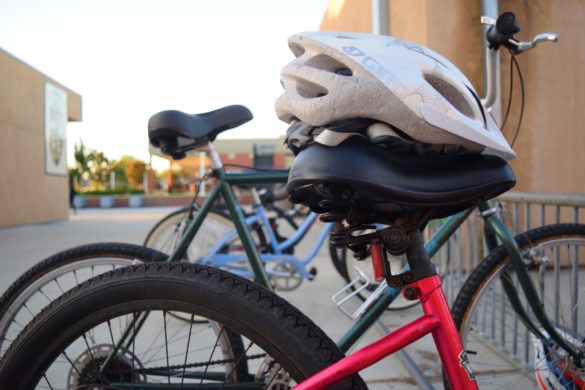
By Jennifer Trend & Ella Scott-Wallace, Staff Writers
Some students choose to commute to school by bike, but not all follow the proper safety standards which keep all students—especially bikers—safe from harm.
From walking, skateboarding, biking and driving to and from school, students use multiple different types of transportation to get to class. At Fountain Valley High School (FVHS) only a few students bike but some do not follow the rules put in place for their safety. Bikers may have more leeway when it comes to taking risks and not following proper bike rules, however; biking can be dangerous if proper safety rules are not taken.
- Wearing helmets
The most important part of bike riding is always going to be wearing a helmet. Even if it may not seem like you need it, or if you think you’re fine without wearing one, you never know when a small mistake can cause you to fall off your bike. Without a helmet, chances of head injury greatly increase to 74%, when those wearing a helmet reduce that risk to 13%.
“We should always be wearing a helmet if you’re on a bike or a skateboard. Nobody wants to do that. It messes up your hair, I get that, but it is safety. So if you’re hit by a car, and you’re not wearing a helmet, the last thing you’re going to be worried about is your hair,” said Supervision Secretary Dawn Basquez. Wearing a helmet is just like wearing a seatbelt, something that is vital to your safety, and should be done immediately before getting on your bike.
- Signaling and being aware of cars and walkers
Bikers might take the liberties to assume that drivers and walkers know where they are going, but in reality, they do not. So make sure that you use signals, and point to where you are going, especially on the road when turning into a street, or going in front of a car in the parking lot. It’s easy to become distracted by other drivers, walkers and anything else you may come across while biking. But try to focus on the road ahead of you and be aware of other pedestrians and drivers.
“Be conscious of [your] surroundings. Understand that [you’re] sharing a road with pedestrians and with cars. And that everyone’s trying to get from A to B at their own speed,” said Basquez.
Getting distracted by something could easily be the reason why you or someone else could get hurt because you were not paying attention to the road ahead of you.
- Bike on the road, not the sidewalk
For many, biking on the sidewalk may feel like a safer option, but it can be more hazardous than using the road. Those who are driving pay more attention to the road rather than the sidewalk, and therefore are unexpecting of any bicyclists—especially on intersections and driveways. Choosing to ride your bicycle on the sidewalk may also be a threat to pedestrians; sidewalks are often too narrow to pass people safely. However, if your only option is to ride on the sidewalk, make sure you ride with the direction of traffic; pay close attention to drivers and never assume they see you; and yield to pedestrians.
- Risk taking/traffic lights
Just like drivers and pedestrians, it’s also important for you to follow the rules of traffic lights. Even if you’re running late, it’s never safe to run a red light or take an unsafe shortcut across the road. Though it may not seem like a big deal, running a red light can easily lead to a fatal accident by unsuspecting vehicles.
- School’s rules on bikes
Just like the state, the school also has rules to adhere to when you bike. The ones students have the most trouble with is getting off their bike before entering campus, and locking up their bikes properly. While it may sound tedious and unnecessary to some, it is there to help the students. Getting off bikes before entering campus prevents from injuring the biker and pedestrians. While it is highly unlikely that someone’s bike would be stolen, it can still happen, and it is better to be on the side of caution, and take the extra thirty seconds to lock your bike up.
- Other recommended things to stay safe, but are not required by law
If possible, avoid riding your bicycle at night; biking in the dark makes it much harder for you to see any pedestrians or hazards such as potholes in the road. It also becomes difficult for drivers to see you, which is why it’s a good idea to have reflectors on the front and back of your bicycle, as well as your tires. Whether you’re riding your bicycle during day or night, wearing something that makes it easier for you to be seen can decrease your risk of being involved in an accident. Try to bike without headphones in, so you can hear the traffic behind and around you. If you do wear headphones, make sure you can hear and be aware of others around you.
Staying safe on and off the road with your bike can help you and others get to school safely, without any injury or harm. All students should be aware of their surroundings, and be conscious of where they are going, whether it’s on a bike, skateboard, or when you are walking or driving.





